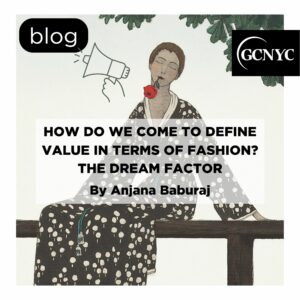
Value
A person’s judgment of what is to be held in high regard in the different aspects of her life. Values are shaped over time by numerous everyday experiences and exposure to social constructs. There are many different aspects to the value of fashion. For the sake of this article, let’s take up the monetary and aesthetic values of fashion.
Here, I argue that fashion’s monetary value is often dominated by its aesthetic value.
Monetary Value
Whether we are getting the full value for our money through the quality, functionality, and longevity of the product that we bought from within our financial boundaries.
Aesthetic Value
Whether we are getting the intangible experience of looking and feeling a certain way out of owning and wearing a garment. (I intentionally omit the “rent the runway” model from this because I want to simplify and generalize upon the majority of fashion consumer behavior/ experience).
Keeping monetary value aside, aesthetic value is the intangible core of fashion. Something’s expensiveness or the lack of it does not exactly bring about value as a whole to a piece of fashion. At least not anymore in this fast-fashion-dominated world. We often consider the value to be associated with meaning. This meaning can be a personal preference or a narrative created by societal actors. The meaning itself forms from a perception of clothing items, the social constructs or conditioning, making it valuable in a particular space and time. The social context is important.
Social context is often dictated to us by many influential actors within the fashion industry. The gatekeeping institutions of the god-like designers, traditional media and celebrities, social media and influencers, and so on and so forth. Items of fashion become trending and viral as we click through advertisements and use #s to promote ourselves as taking part in this social game. This system provides its consumers with visual cues. The theories of fashion apply here (trickle down, up, or across). We hardly make individual choices; our choices are increasingly part of the social fabric we construct through storytelling on the many platforms available to us today. The ability of a piece of clothing to go viral, that is become fashion has changed in the past years.
The democratization of fashion for which industrialization, neoliberal capitalism, and social media are responsible has led to the exclusivity of designs being dissolved. This was in fact much needed to break the classist approach the industry had but we cannot ignore the damage knockoffs have brought to designer intellectual properties.
Luxury is actually positioned/targeted at customers who aspire to be rich enough to afford those. Some of the people with higher spending power don’t mind spending 1000s of dollars on cheap fast fashion because they value quantity over quality and fashion has become as disposable as used tissue paper. This behavior indicates the dominance of “aesthetic”.
Between this, there is a segment of customers who value their monetary boundaries, quality, and personal style than quantity and the aspiration to be seen as rich or powerful. Studies reveal that luxury pricing has two parts, one part being making charges (raw materials, labor, transportation, etc.), and then we are charged for the brand name or markups (depending on the brand positioning). The more you pay the more exclusive the product is. Luxury retailers let aspirational potential customers dip their toes into the luxury world through extended product lines of perfumes, eyewear, cosmetics, etc. The customers get a taste and want more, when they have the money (even if that means saving up for a few months) they’ll come back.
Status culture has led us here. The majority of us buy not because we really like that design, it has personal implications for us or because we trust the quality, we buy because we think we can buy social status and others’ approval to justify that we are living the dream.
Authored by Anjana Baburaj, an alumna and GCNYC’s Communication Strategist and Content Creator. To learn more about her work click here.

